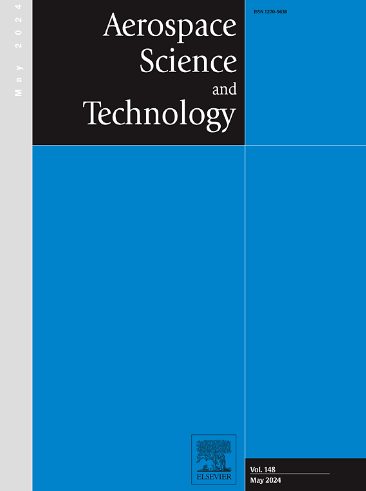Derivation of analytic formulae for several resonance frequencies of the SparkJet actuator
IF 5
1区 工程技术
Q1 ENGINEERING, AEROSPACE
引用次数: 0
Abstract
Building on previous research that emphasized the importance of focusing on resonance frequencies for a fundamental understanding of the thrust and complex internal flow phenomena of the SparkJet actuators, this study theoretically derives analytic formulae for several important resonance frequencies. The research addresses the typical configuration of the SparkJet actuators, which consists of a cylindrical cavity and orifice connected by a conical converging nozzle. While the resonance frequencies of the SparkJet actuators can be obtained by solving the eigenvalue problem presented in previous studies, this eigenvalue problem, despite being a typical boundary value problem in the form of an elliptic partial differential equation, is challenging to solve using conventional numerical methods such as iterative methods, because the eigenvalue is included as an unknown in the operator. Consequently, Boundary Element Method (BEM) or methods using the Green functions have been proposed to obtain numerical solutions, but these still require handling large matrix data, resulting in significant computational costs and memory consumption. To overcome this, the current study first simplifies the eigenvalue problem using the conformal mapping presented in previous research. Then, referencing prior studies that claim that three types of resonance frequencies (Helmholtz resonance frequency and resonance frequencies representing streamwise or radial directional oscillation) significantly affect the thrust of the SparkJet actuators, characteristics of these frequencies are mathematically defined. Using these mathematical characteristics, the study derives the asymptotic and approximate solutions of the simplified eigenvalue problem, from which the resonance frequencies are obtained. The analytic formulae proposed in this study theoretically explain the already known geometric tendencies of the resonance frequencies and reveal new geometric factors influencing resonance frequencies, which were previously unknown. This approach is expected to facilitate obtaining several important resonance frequencies of the SparkJet actuator more promptly and accurately and to provide a deeper understanding of the nature of the complex oscillation phenomena inside the actuator.
推导出火花喷射致动器若干共振频率的解析公式
以前的研究强调,要从根本上了解 SparkJet 激励器的推力和复杂的内部流动现象,就必须关注共振频率,在此基础上,本研究从理论上推导出了几个重要共振频率的解析公式。研究涉及 SparkJet 激励器的典型配置,它由一个圆柱形空腔和孔口组成,并由一个锥形会聚喷嘴连接。虽然 SparkJet 激励器的共振频率可以通过求解以往研究中提出的特征值问题来获得,但这个特征值问题尽管是一个典型的椭圆偏微分方程形式的边界值问题,却很难用传统的数值方法(如迭代法)来求解,因为特征值作为一个未知数包含在算子中。因此,人们提出了边界元法(BEM)或使用格林函数的方法来获得数值解,但这些方法仍然需要处理大量矩阵数据,从而导致大量计算成本和内存消耗。为了克服这一问题,本研究首先利用之前研究中提出的保角映射简化了特征值问题。然后,参考之前的研究,即三种共振频率(亥姆霍兹共振频率和代表流向或径向振荡的共振频率)对 SparkJet 激励器的推力有显著影响,对这些频率的特征进行了数学定义。利用这些数学特征,研究得出了简化特征值问题的渐近和近似解,并从中获得了共振频率。本研究提出的解析公式从理论上解释了已知的共振频率几何趋势,并揭示了以前未知的影响共振频率的新几何因素。预计这种方法将有助于更快、更准确地获得 SparkJet 激励器的几个重要共振频率,并加深对激励器内部复杂振荡现象本质的理解。
本文章由计算机程序翻译,如有差异,请以英文原文为准。
求助全文
约1分钟内获得全文
求助全文
来源期刊

Aerospace Science and Technology
工程技术-工程:宇航
CiteScore
10.30
自引率
28.60%
发文量
654
审稿时长
54 days
期刊介绍:
Aerospace Science and Technology publishes articles of outstanding scientific quality. Each article is reviewed by two referees. The journal welcomes papers from a wide range of countries. This journal publishes original papers, review articles and short communications related to all fields of aerospace research, fundamental and applied, potential applications of which are clearly related to:
• The design and the manufacture of aircraft, helicopters, missiles, launchers and satellites
• The control of their environment
• The study of various systems they are involved in, as supports or as targets.
Authors are invited to submit papers on new advances in the following topics to aerospace applications:
• Fluid dynamics
• Energetics and propulsion
• Materials and structures
• Flight mechanics
• Navigation, guidance and control
• Acoustics
• Optics
• Electromagnetism and radar
• Signal and image processing
• Information processing
• Data fusion
• Decision aid
• Human behaviour
• Robotics and intelligent systems
• Complex system engineering.
Etc.
 求助内容:
求助内容: 应助结果提醒方式:
应助结果提醒方式:


